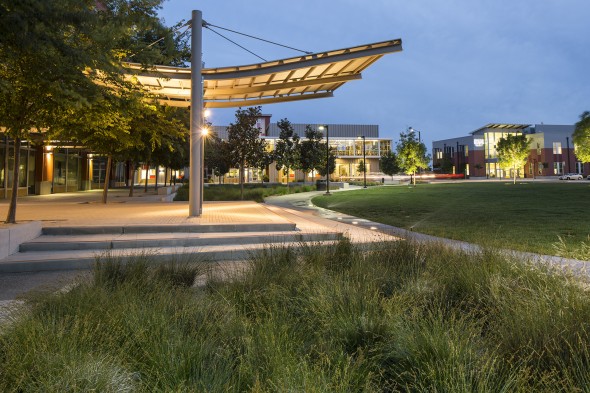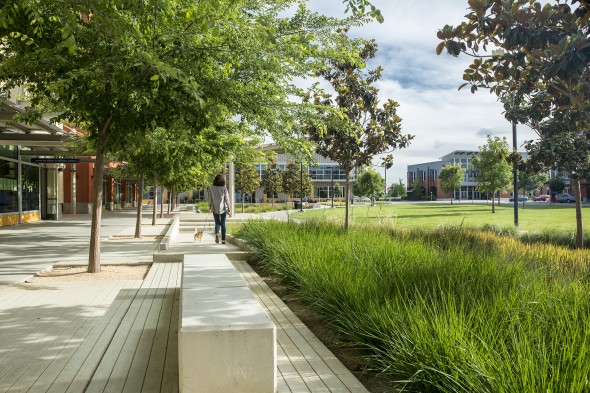
swa helps to create nation’s largest planned net-zero energy community.
click on image > lightbox navigation
International landscape architecture, planning and urban design firm SWA provided key planning and landscape strategies for the nation’s largest planned Zero-Net Energy (ZNE) community for the University of California, Davis (UC Davis). A unique public-private partnership between UC Davis and developer West Village Community Partnership (WVCP) made the project possible.
Initially conceived as an “environmentally responsible campus housing project,” the 225-acre neighborhood West Village project ultimately transformed into a ZNE community, which uses “zero net electricity from the grid, measured on an annual basis.” SWA provided master planning, site planning, and landscape strategies to help realize the ambitious vision.
SWA’s sustainable initiatives support the project’s core principles of housing affordability, environmental responsiveness, and quality of place. The new campus neighborhood will provide housing for 3,000 students and 500 staff/faculty families within a network of parks, storm water ponds and corridors, bicycle and pedestrian trails, a community college, and retail and recreational services.
UC Davis launched the West Village Energy Initiative (WVEI) in cooperation with WVCP in 2003, to study energy efficiency measures, with an initial target of 50 percent reduction in consumption compared to the California Energy Efficiency Building Code. By 2008, the WVEI proposed that West Village could become a ZNE community without sacrificing quality, and at no increased cost to developer or consumer.
Phase 1A of the West Village development is now complete, housing 1,944 students at 99 percent occupancy. Phase 1A also comprises 42,500 square feet of retail/office space and a leasing/recreation center, centered on Village Square, an open, communal space. The ground floors of mixed-use Village Square buildings comprise the university’s first “uHub,” or innovation center, which includes the Plug-In Hybrid & Electric Vehicle Research Center and the Western Cooling Efficiency Center.
Robert Segar, Assistant Vice Chancellor for Campus Planning and Community Resources at UC Davis, states: “All parties saw tremendous value in reaching the goals. If one path toward Zero Net Energy didn’t work, we were willing to try another path. The phrase ‘Zero Net Energy’ was central to this; its absolute clarity became our guiding principle.”
SWA’s site planning and landscape strategies for the West Village development encompassed three major areas: Energy Systems, Community-wide Connectivity, and High-performance Landscape.
Within Energy Systems, SWA worked to integrate energy conservation and on-site energy generation in a functional and aesthetic manner, in harmony with local environmental conditions. SWA conducted analyses at regional, site, and building/garden scales in order to maximize opportunities for passive cooling, proposing to arrange buildings in loose clusters that allow breezes from the Bay Delta to filter through the site. SWA also proposed the planting of shade-giving deciduous trees, reducing the need for air conditioning.
In considering Community-wide Connectivity, SWA posited the bicycle as the site’s primary mode of transportation, based on the well-established bike culture of Davis, in combination with the site’s flat topography. SWA developed a five-mile network of bicycle trails, offering access to both community destinations and the main campus. This network also connects to other transit, fulfilling the objective of locating each residence no more than a quarter mile from the campus bus line.
To achieve a High-Performance Landscape, SWA integrated drainage into the site’s system of parks, sports fields, trails, and gardens. Storm water drains to the site’s large northern ponds, where it is purified by native wetland planting in a series of basins. The slopes of the site’s ponds incorporate native shrubs and trees, selected in cooperation with UC Davis’ horticulturists, botanical garden curators, and ground and maintenance pewrsonnel, to provide a sustainable habitat for migratory birds, while also providing a visually appealing natural landscape for residents year-round.
Robert Segar adds: “SWA was the one point of continuity in the design and implementation process. They met both the university’s goals of working successfully across scales, from community-scale natural drainage and landscape strategies to plant selection and coordination with our horticulture experts, as well as big-picture ZNE goals.”
UC Davis’ internal monitoring shows that the West Village ZNE community achieved an exceptional 87 percent of initial ZNE goals in its first year. In 2013, West Village received the ULI Global Award of Excellence, which honors outstanding development in both the private and public sectors, with an emphasis on responsible land use.
[ swa ] images courtesy of swa / photo credits > david llyod/swa & jonnu singleton




